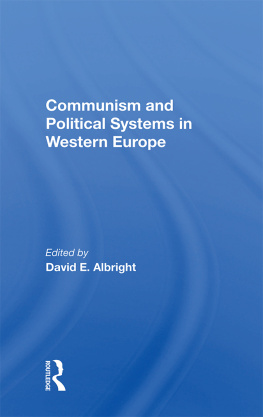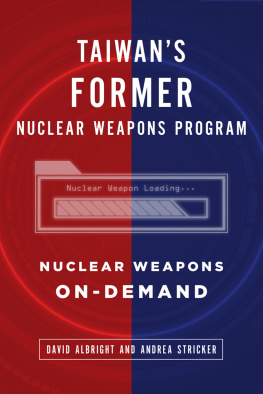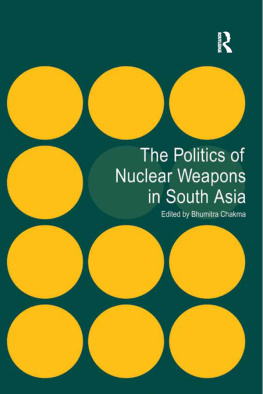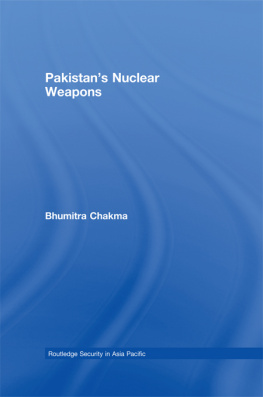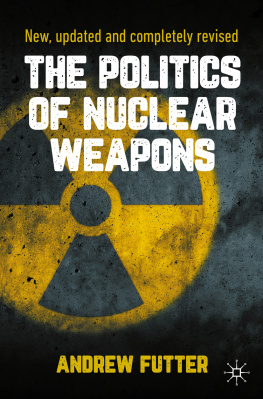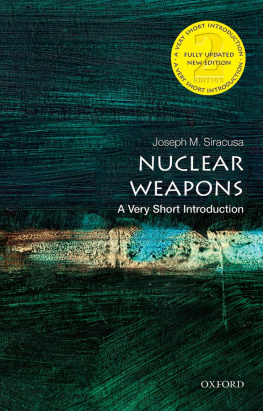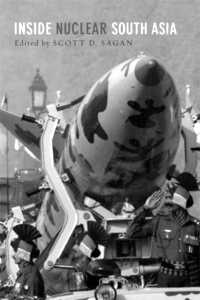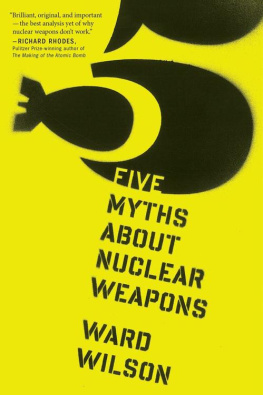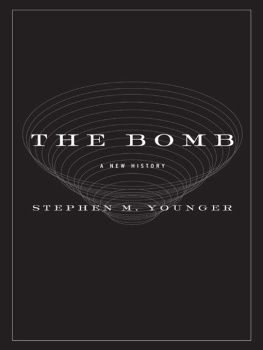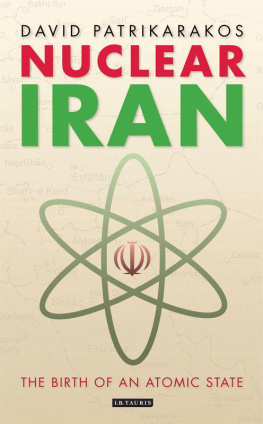David Albright - Revisiting South Africas Nuclear Weapons Program: Its History, Dismantlement, and Lessons for Today
Here you can read online David Albright - Revisiting South Africas Nuclear Weapons Program: Its History, Dismantlement, and Lessons for Today full text of the book (entire story) in english for free. Download pdf and epub, get meaning, cover and reviews about this ebook. year: 2016, genre: Politics. Description of the work, (preface) as well as reviews are available. Best literature library LitArk.com created for fans of good reading and offers a wide selection of genres:
Romance novel
Science fiction
Adventure
Detective
Science
History
Home and family
Prose
Art
Politics
Computer
Non-fiction
Religion
Business
Children
Humor
Choose a favorite category and find really read worthwhile books. Enjoy immersion in the world of imagination, feel the emotions of the characters or learn something new for yourself, make an fascinating discovery.

- Book:Revisiting South Africas Nuclear Weapons Program: Its History, Dismantlement, and Lessons for Today
- Author:
- Genre:
- Year:2016
- Rating:3 / 5
- Favourites:Add to favourites
- Your mark:
- 60
- 1
- 2
- 3
- 4
- 5
Revisiting South Africas Nuclear Weapons Program: Its History, Dismantlement, and Lessons for Today: summary, description and annotation
We offer to read an annotation, description, summary or preface (depends on what the author of the book "Revisiting South Africas Nuclear Weapons Program: Its History, Dismantlement, and Lessons for Today" wrote himself). If you haven't found the necessary information about the book — write in the comments, we will try to find it.
Revisiting South Africas Nuclear Weapons Program: Its History, Dismantlement, and Lessons for Today — read online for free the complete book (whole text) full work
Below is the text of the book, divided by pages. System saving the place of the last page read, allows you to conveniently read the book "Revisiting South Africas Nuclear Weapons Program: Its History, Dismantlement, and Lessons for Today" online for free, without having to search again every time where you left off. Put a bookmark, and you can go to the page where you finished reading at any time.
Font size:
Interval:
Bookmark:

Revisiting South Africas Nuclear Weapons Program
Its History, Dismantlement, and Lessons for Today
David Albright
with Andrea Stricker
Institute for Science and International Security
June 2016
Institute for Science and International Security
The Institute for Science and International Security is a non-profit, non-partisan institution dedicated to informing the public about science and policy issues affecting international security. Its primary focus is on stopping the spread of nuclear weapons and related technology to additional nations and to terrorists, bringing about greater transparency of nuclear activities worldwide, strengthening the international non-proliferation regime, and achieving deep cuts in nuclear arsenals.
Copyright 2016 by Institute for Science and International Security
Institute for Science and International Security (ISIS) Press
440 1 st Street NW
Suite 800
Washington, DC 20001
USA
www.isis-online.org
@TheGoodISIS
Front cover photograph credits: Armscor and Uranium Enrichment Corporation of South Africa Limited.
All unsourced photos in the book are from David Albright.
Dedicated to all those who strive for a world free of nuclear weapons.
Twenty five years ago South Africa acceded to Nuclear Non-Proliferation Treaty after dismantling its nuclear weapons. Yet, the full story of that nuclear weapons program was not revealed publicly at that time. Parts were hidden from the International Atomic Energy Agency as well. Now, after many years of work by the media and independent experts, with the cooperation of a number of former members of the nuclear weapons program, a much fuller picture of South Africas nuclear weapons program has emerged.
At the Institute for Science and International Security, work on South Africas nuclear program goes back to its founding in 1992. One of its first projects was working with African National Congress (ANC) officials, who were interested in learning more about nuclear non-proliferation in anticipation of assuming key government positions in a democratic South African government. This cooperation led to contacts with several former members of South Africas nuclear weapons program and a range of collaborative endeavors with them. It included two tours of the old nuclear weapons production sites. On the trip in August 2002, Albright was allowed to photograph the old weapon production sites before they were modified beyond recognition of their original purpose. Many of these images appear here for the first time.
We at the Institute are pleased to present the first comprehensive, technically-oriented history of South Africas nuclear weapons program and its dismantlement. Although not every question could be answered, this history reveals a great deal of new information about that program.
This book also takes stock of the lessons today of this dynamic and complicated nuclear weapons program. Although none of the nine states that currently possess nuclear weapons appear on the verge of following South Africas example, the South African case contains many valuable lessons in non-proliferation, disarmament, export controls, and verification.
We hope that this book will therefore be regarded as a useful contribution to policy debates and a compendium of information on South Africas nuclear weapons program and its dismantlement.
Revisiting South Africas Nuclear Weapons Program is made possible in large part by support from the Project on Advanced Systems and Concepts for Countering Weapons of Mass Destruction (PASCC), Center on Contemporary Conflict, Naval Postgraduate School, under Grant No. N00244-15-1-0005. PASCC is supported by the Defense Threat Reduction Agency (DTRA). In addition, the research of this report has been supported over the years by a range of US foundations, too large to enumerate. However, we want to single out the Rockefeller Foundation for its support of our work with the African National Congress nuclear policy group in the early 1990s.
We would also like to thank members and officials from the African National Congress, Armscor, and the Atomic Energy Corporation, and its successor organization South African National Nuclear Corporation. Several individuals at the International Atomic Energy Agency (IAEA) were also invaluable, and we thank them as well.
We also thank Jerrica Goodson, who while working at the Institute, assisted in the preparation of this report. Finally, we thank the participants of a May 2016 presentation at the George Washington University Elliott School of International Affairs who informed and improved this report.
South Africas nuclear development dates back to World War II when the US Manhattan Project was looking worldwide for uranium to make nuclear weapons. In 1944 Great Britain requested South Africas Prime Minister Jan Smuts to investigate reported deposits of uranium in South Africa and South West Africa (now called Namibia).
After several years of exploration and development, South Africa started its first full-scale uranium extraction plant in 1952, built with extensive US and British aid. By 1955 sixteen uranium extraction plants were in operation. Until the mid-1960s, South African uranium was sold to the Combined Development Agency, the purchasing organization created by Britain and the United States to obtain adequate uranium supplies for their nuclear weapons programs.
Initially, the development of uranium production was controlled directly by the South African Prime Ministers office. However, in 1948 the countrys Atomic Energy Board (AEB) was established by an Act of Parliament to control all nuclear matters, particularly the production and sale of uranium on behalf of the government.
The First United Nations Conference on the Peaceful Uses of Atomic Energy, held in Geneva in 1955, stimulated the AEBs interest in creating an indigenous South African nuclear research and development program. Upon its return, the South African mission to the UN conference recommended that South Africa send scientists abroad for training to enable them to build an experimental reactor. It also recommended the construction of a nuclear power reactor at Cape Town.
In November 1956, the AEB established the Research Advisory Committee. One of its first acts was to appoint A. J. A. Ampie Roux, then a senior official at the Council for Scientific and Industrial Research (CSIR), to draft a nuclear research and development program. The committee also hired the AEBs first two research engineers. They were charged with surveying the processes for producing heavy water as a moderator in nuclear reactors.
One month later, the government created a national Commission of Enquiry into the Application of Nuclear Power in South Africa, under terms of reference drafted by the AEB. The commission appointed Roux to draft a plan for a South African nuclear research and development program.
While Roux was producing his report, the two AEB engineers started to investigate heavy water in the first applied research undertaken by full-time AEB staff. The AEB had come to believe that it could economically produce heavy water. After six months of study in South Africa, the two AEB engineers spent 18 months working intensively with the Heavy Water Group at the Harwell Atomic Energy Research Establishment in Britain. They also visited heavy water plants in Germany.
Roux spent about a year and a half developing his draft plan for a South African nuclear research and development program. After visiting ten countries, interviewing hundreds of experts, and seeking the views of South African governmental, mining, and industrial authorities, he presented his plan to the AEB in June 1958.
Font size:
Interval:
Bookmark:
Similar books «Revisiting South Africas Nuclear Weapons Program: Its History, Dismantlement, and Lessons for Today»
Look at similar books to Revisiting South Africas Nuclear Weapons Program: Its History, Dismantlement, and Lessons for Today. We have selected literature similar in name and meaning in the hope of providing readers with more options to find new, interesting, not yet read works.
Discussion, reviews of the book Revisiting South Africas Nuclear Weapons Program: Its History, Dismantlement, and Lessons for Today and just readers' own opinions. Leave your comments, write what you think about the work, its meaning or the main characters. Specify what exactly you liked and what you didn't like, and why you think so.

